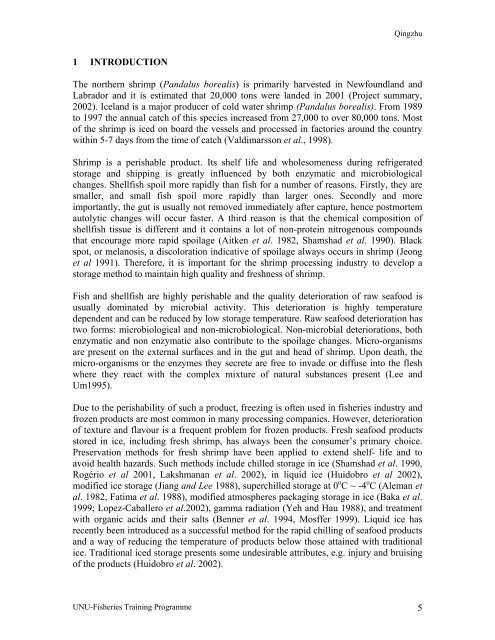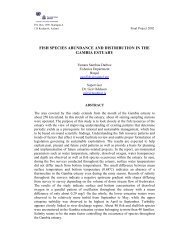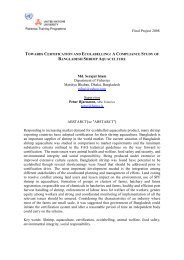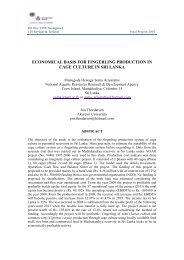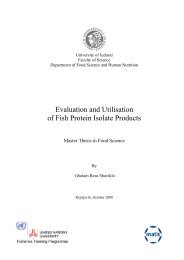Quality Indicators of Northern Shrimp (Pandalus borealis)
Quality Indicators of Northern Shrimp (Pandalus borealis)
Quality Indicators of Northern Shrimp (Pandalus borealis)
Create successful ePaper yourself
Turn your PDF publications into a flip-book with our unique Google optimized e-Paper software.
Qingzhu1 INTRODUCTIONThe northern shrimp (<strong>Pandalus</strong> <strong>borealis</strong>) is primarily harvested in Newfoundland andLabrador and it is estimated that 20,000 tons were landed in 2001 (Project summary,2002). Iceland is a major producer <strong>of</strong> cold water shrimp (<strong>Pandalus</strong> <strong>borealis</strong>). From 1989to 1997 the annual catch <strong>of</strong> this species increased from 27,000 to over 80,000 tons. Most<strong>of</strong> the shrimp is iced on board the vessels and processed in factories around the countrywithin 5-7 days from the time <strong>of</strong> catch (Valdimarsson et al., 1998).<strong>Shrimp</strong> is a perishable product. Its shelf life and wholesomeness during refrigeratedstorage and shipping is greatly influenced by both enzymatic and microbiologicalchanges. Shellfish spoil more rapidly than fish for a number <strong>of</strong> reasons. Firstly, they aresmaller, and small fish spoil more rapidly than larger ones. Secondly and moreimportantly, the gut is usually not removed immediately after capture, hence postmortemautolytic changes will occur faster. A third reason is that the chemical composition <strong>of</strong>shellfish tissue is different and it contains a lot <strong>of</strong> non-protein nitrogenous compoundsthat encourage more rapid spoilage (Aitken et al. 1982, Shamshad et al. 1990). Blackspot, or melanosis, a discoloration indicative <strong>of</strong> spoilage always occurs in shrimp (Jeonget al 1991). Therefore, it is important for the shrimp processing industry to develop astorage method to maintain high quality and freshness <strong>of</strong> shrimp.Fish and shellfish are highly perishable and the quality deterioration <strong>of</strong> raw seafood isusually dominated by microbial activity. This deterioration is highly temperaturedependent and can be reduced by low storage temperature. Raw seafood deterioration hastwo forms: microbiological and non-microbiological. Non-microbial deteriorations, bothenzymatic and non enzymatic also contribute to the spoilage changes. Micro-organismsare present on the external surfaces and in the gut and head <strong>of</strong> shrimp. Upon death, themicro-organisms or the enzymes they secrete are free to invade or diffuse into the fleshwhere they react with the complex mixture <strong>of</strong> natural substances present (Lee andUm1995).Due to the perishability <strong>of</strong> such a product, freezing is <strong>of</strong>ten used in fisheries industry andfrozen products are most common in many processing companies. However, deterioration<strong>of</strong> texture and flavour is a frequent problem for frozen products. Fresh seafood productsstored in ice, including fresh shrimp, has always been the consumer’s primary choice.Preservation methods for fresh shrimp have been applied to extend shelf- life and toavoid health hazards. Such methods include chilled storage in ice (Shamshad et al. 1990,Rogério et al 2001, Lakshmanan et al. 2002), in liquid ice (Huidobro et al 2002),modified ice storage (Jiang and Lee 1988), superchilled storage at 0 o C ~ -4 o C (Aleman etal. 1982, Fatima et al. 1988), modified atmospheres packaging storage in ice (Baka et al.1999; Lopez-Caballero et al.2002), gamma radiation (Yeh and Hau 1988), and treatmentwith organic acids and their salts (Benner et al. 1994, Mosffer 1999). Liquid ice hasrecently been introduced as a successful method for the rapid chilling <strong>of</strong> seafood productsand a way <strong>of</strong> reducing the temperature <strong>of</strong> products below those attained with traditionalice. Traditional iced storage presents some undesirable attributes, e.g. injury and bruising<strong>of</strong> the products (Huidobro et al. 2002).UNU-Fisheries Training Programme 5


